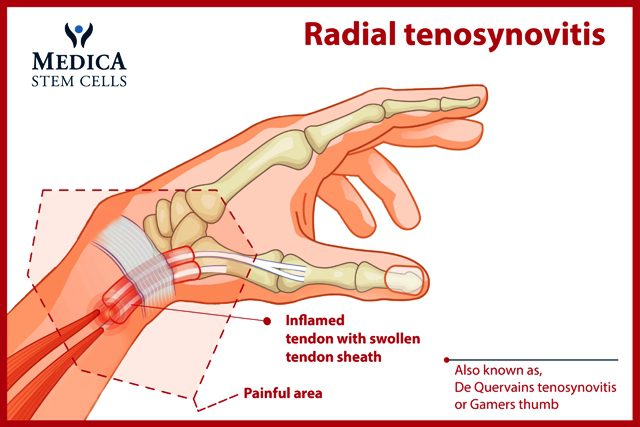
Exciting New Health & Beauty Treatments at Medica Stem Cells, Beacon Court, Sandyford, Dublin
We are thrilled to announce the expansion of our services at Medica Stem Cells in Beacon Court, Sandyford, Dublin! …
OPT FOR AN EARLY DIAGNOSIS TO UNDERGO TIMELY RADIAL TENOSYNOVITIS/ DE QUERVAIN’S TENOSYNOVITIS/ GAMER’S THUMB TREATMENT IN THE UK, IRELAND AND AHMEDABAD
Do you love playing video games but cannot play for a long time? You may have the Gamer’s thumb, otherwise known medically as Radial tenosynovitis or De Quervain’s tenosynovitis. It is also known by its many nicknames like PlayStation thumb, Nintendo thumb, WASD Wrist and Nintendonitis.
Though the names sound a bit specific to gaming word, radial tenosynovitis can occur for any person. Let us dive into the topic and learn its causes, symptoms and how Medica Stem Cells treatment may help with Gamer’s thumb treatment.
Radial tenosynovitis is a painful inflammation of tendons in the lower thumb and wrist. As these tendons swell, they rub against the narrow tunnel they pass through. It causes inflammation of the sheaths covering the tendons. Hence, there will be intense pain in the lower portion of your thumb and the lower arm.

The exact cause of De Quervain’s tenosynovitis (Radial tenosynovitis) is unknown. However, it usually results from:
As mentioned already, anyone can get radial tenosynovitis. However, the following factors make it more likely:
If you are having radial tenosynovitis, you will experience pain and swelling:
This condition can take place suddenly or aggravate gradually. The pain will migrate into the thumb or your forearm. It may be painful or even hard to move the thumb. You may undergo discomfort while pinching or holding things. If you try to move your wrist or thumb forcibly, the pain may worsen.
Other symptoms include:
Your physician will perform a range of tests to diagnose De Quervain’s tenosynovitis, like putting pressure on the thumb portion of your wrist and checking whether it evokes pain or not. Next, the physician will perform a Finkelstein test, where you will fold your thumb across the palm. Make a fist by bending your remaining fingers down over the thumb. While doing this, you will be stretching your tendons. If it hurts on the thumb portion of your wrist, you have radial tenosynovitis.
Usually, your physician does not require an X-ray test, MRI or ultrasound scan to diagnose this condition.
Radial tenosynovitis treatment aims at relieving pain and inflammation while moving your thumb. Similarly, the treatment should prevent the occurrence of this condition. Hence, you may first undergo the following conventional methods listed below:
Wear the splint to hold your wrist and thumb firmly. You can wear it round-the-clock for 4-6 weeks. You will be doing specific physical therapies provided by your physiotherapist to strengthen your arm, hand and wrist.
Your physician will prescribe non-steroidal anti-inflammatory drugs (NSAIDs) to ease your pain and swelling.
Physicians may recommend steroids in case if medications don’t work.
However, the administration of medications and steroids for a prolonged duration may lead to severe complications. Hence, your physician will never recommend them for a longer duration.
If all the above-listed modalities don’t provide any significant improvement, your physician may recommend surgery. The surgical method is comparatively successful at resolving this ailment. Surgery aims at releasing your tendon sheath. By doing so, the tendon will move smoothly. It is a same-day outpatient procedure, and you can go home within a few hours after the completion of surgery. Your stitches will be removed in 10-14 days. The pain and inflammation may subside immediately after the surgery. However, the surgical area may remain tender for a few months.
Furthermore, you will have to undergo post-surgical physical therapy that includes wrist and thumb strengthening exercises. You will be continuing these exercises for 6-8 weeks. You will also undergo stretches to move your tendons properly.
According to the research article published in the year 2003, surgery was performed to release tendons of the wrist’s first dorsal compartment. And what was the outcome? This surgery proved to be 96% successful among patients with radial tenosynovitis. They recovered entirely from the associated radial tenosynovitis symptoms.*
Radial tenosynovitis/ Gamer’s thumb responds well to treatment. However, if you leave it untreated, it may permanently restrict your wrist movements. Your tendon sheath may also burst in a severe condition. Hence, we recommend you to undergo appropriate treatment for radial tenosynovitis. Don’t let radial tenosynovitis worsen your wrist and lower thumb movements. Get an early diagnosis to undergo suitable and timely Gamer’s thumb treatment in the UK, Ireland and Dubai.
Your first step to exploring Gamer’s thumb treatment in the UK is scheduling a consultation with our Consultant. To do so call us from the UK on 020 8168 2000 or Ireland on 01 298 8000. Alternatively, book a consultation online or request a calll back today!
References:
Zarin M, Ahmad I. Surgical treatment of de Quervain’s disease. J Coll Physicians Surg Pak. 2003 Mar;13(3):157-8. PMID: 12689535.

We are thrilled to announce the expansion of our services at Medica Stem Cells in Beacon Court, Sandyford, Dublin! …

Living with chronic knee osteoarthritis and joint pain can be debilitating, affecting daily activities and overall quality of life. The myriad treatment options healthcare professionals…

Regenerative medicine, specifically platelet-rich plasma (PRP) treatment, is gaining recognition in orthopedic surgery and sports medicine for its ability to

We use essential cookies to make our site work. We'd also like to set analytics cookies that help us make improvements by measuring how you use the site. Clicking Reject All only enables essential cookies. For more detailed information about the cookies we use, see our Cookies page. For further control over which cookies are set.
Thank you {{_full_name}}!
We will be in contact with you shortly.